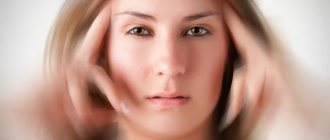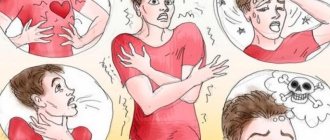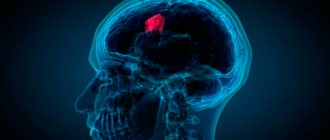Neurosis
View gallery
Neurosis is a specific mental state that arises as a result of serious psychological trauma or a person’s prolonged stay in a stressful situation. Its symptoms exhaust the human body, causing disruptions in the functioning of the autonomic system (indigestion, accelerated pulse, profuse sweating). They are accompanied by fatigue, irritation at the slightest provocation, anxiety for no particular reason, an aggressive state from any irritant, and so on. Despite all the disturbing signs, the carrier of neurosis clearly thinks and acts quite rationally. If he has a strong will, he is able to control himself and independently carry out the necessary treatment.
What is neurosis?
Neurosis is a disease of the nervous system associated with its disorder.
How to distinguish between psychosis and neurosis? If psychosis is an irreversible disease in some cases, then when treating neurosis, on the contrary, the outcome is more favorable and the patient can fully recover.
Treatment of psychosis in some cases is difficult, but neurosis is easier to eliminate using certain techniques. The following are susceptible to psychosis:
- children whose parents abuse alcoholic beverages and drugs, psychotropic drugs or already suffer from psychosis;
- adults who suffered psychological trauma in childhood;
- adults using heavy medications and others.
But if we talk about neurosis, then almost every person can be brought to this state, especially with a character and psyche less resistant to stressful situations. Neurosis can occur as a result of a nervous illness, a severe life shock, for example, the loss of a loved one, a breakup of a relationship, stress, even some changes in life, physical fatigue, or heavy workload.
And this is not a complete list of reasons leading to the occurrence of neuroses. Neurosis makes itself felt when a person experiences an anxious state, often cries and gets upset, is visited by depressive thoughts and experiences, and these phenomena may be accompanied by frequent headaches, an increase or decrease in blood pressure.
However, if you pull yourself together in time, you can eliminate this problem. But, of course, it would not be a bad idea to seek help from a neurologist who will give recommendations on how to treat a nervous condition.
Causes of neuroses
View gallery
Most often, the onset of neurosis is provoked by events that cause enormous stress to the nervous system, or a prolonged state of tension. Less common are cases of hereditary predisposition, environmental influences or poor lifestyle choices. Loading himself with work up to his shoulders, which also brings emotional shocks, he accidentally leads himself to a nervous breakdown. Chronic diseases that debilitate the human body have an additional impact.
Causes of pathological conditions
The cause of neurosis is a disruption of the nervous system due to some internal or external pathogenic factors. The most common factors that influence its occurrence are chronic fatigue, stress, unfavorable social relationships (especially in childhood), etc.
It’s different with psychosis. This pathology is characterized by strong and difficult to reversible abnormalities not only of the nervous system, but also of the brain. The reasons for this may be:
- strong emotional shocks;
- physical head injuries;
- infectious processes;
- severe intoxication of the body;
- long-term use of drugs.
Changes in behavior are observed, the perception of the world changes. Signs of psychosis are more noticeable, unusual for a person with a healthy psyche.
Psychosis
View gallery
Psychosis is a pathology of the human psyche, which becomes the cause of original behavior that is not included in the generally accepted framework of society. The patient does not see the real world around him, but something ephemeral created by his own brain. He reacts inappropriately to any stimulus, further enhancing the strange impression of his behavior.
Depending on the reasons that contribute to its appearance, psychosis can be of several types:
- Psychosis of organic origin - occurs as a result of poor functioning of a region of the brain. This is partly due to wear and tear on blood vessels and head injuries.
- Endogenous psychoses - they are provoked by disruptions in neurohumoral regulation.
- Exogenous psychoses are the consequences of severe stress or pathological dependence on drugs and alcohol. Sometimes they are caused by infections that affect the central nervous system.
What is psychosis?
Psychosis is a disease of the human psyche, which manifests itself in strange, illogical behavior and is expressed in a disorder in the perception of reality.
How does psychosis manifest in children and adults? In childhood, psychosis can manifest itself in the form of hallucinations or delusions. As a rule, a sick child is different from other children, which makes it possible to timely diagnose and identify the causes of such behavior and provide appropriate treatment. It is easier to understand the reason for a child’s unusual behavior when he already knows how to speak. Often, children tend to fantasize, exaggerate, invent and describe non-existent things and phenomena so colorfully that sometimes parents may not attach any importance to this. But if at the same time the child has other signs indicating a clearly unhealthy condition, then you should consult a doctor.
Symptoms of childhood psychosis include:
- elevated temperature;
- headache;
- speech disorders;
- developmental delay;
- motor impairment and other signs.
Therefore, parents must carefully monitor how their baby develops. And if in any doubt, it is better to play it safe and consult a doctor.
As for psychosis in an adult, this mental disorder can either stretch from childhood or be acquired as a result of a number of factors:
- alcoholism;
- severe psychological trauma;
- genetic predisposition.
Manifestations of psychosis in an adult can include hallucinations, delusional conclusions, hysterical attacks, convulsions, and attacks of “delirium tremens” in alcohol-dependent people.
Symptoms of psychosis
View gallery
The symptoms of neuroses and psychoses differ from each other. A person with psychosis hallucinates and delusions. He perceives the surrounding reality differently, reacting sharply to any sensations. His emotional background either heats up or weakens, temporarily acquiring the appearance of stability. The patient's mood changes dramatically, falling from a wide smile to deep melancholy and back in a couple of seconds.
A person with a mental illness moves chaotically, sometimes speaking in abrupt, barely understandable phrases. After recovery, such people say that their condition resembled a sleepy dope that lasts for days.
Reasons for the lack of definition
What is the difference between psychosis and neurosis and is there a relationship between these conditions? It is quite difficult to answer this question due to the lack of clear boundaries between these states. Man is unable to define the human mind and soul. The times when most experts believed that nervous situations are the cause of all diseases are long gone. When creating the term "psychosis", two Greek words were used, ψυχ - meaning the mind or soul, and ωσις - which is used to denote a disturbed consciousness.
Today it is impossible to fully study human consciousness, however, it is possible to identify the presence of deviations from the generally accepted norm using special diagnostic methods.
The nature of the diseases in question can be explained using the method of cause and effect. According to Sigmund Freud, psychosis is a mental disorder that is included in the same group of diseases as perversions and neurosis. Only a decade later, the scientist came to the conclusion that psychosis is the result of a conflict between the inner “I” and the perception of the external world, while “neurosis” is characterized by a conflict between “I” and “it”. It is important to note that it was Sigmund Freud, in the mid-twenties of the last century, who put forward the theory that paranoid schizophrenia belongs to the category of endogenous diseases. It is quite difficult for an uninitiated person to understand the connection between the conflict and the surrounding reality and the inner self.
Carl Jung, in his scientific works, said that psychosis is the result of filling consciousness with unconscious archetypes. In simple terms, this condition can be compared to a filling bathtub that the sloppy owner forgot about. The difference between neurosis and psychosis lies in the amount of spilled water that “stepped over” the sides of the bathroom. In reality, the clarity of the boundaries between these states is very conditional.
“Psychosis” is a word that is perceived negatively by many people, and is understood as the inability to influence one’s own condition. It is precisely this perception of this diagnosis that has led to the fact that in certain cases it is replaced with “neurosis.” The admissibility of such a replacement is explained by the fact that some elements of the clinical picture relate to both one and another disease.
The reactive form of psychosis has many similarities with neuroses due to the ability to reverse mental disorders. It is important to note that a reactive form of psychosis, like neuroses, can develop in patients diagnosed with paranoid psychopathy, which is an irreversible disease. Experts say that both diseases require immediate access to qualified medical care, due to the high risk of developing serious complications.
Neurosis, according to statistics, is present in approximately 16-22% of the population, depending on the region
General differences
Despite the general similarities, these are completely different diseases. Experts highlight several significant points that allow us to understand how to distinguish neurosis from psychosis. These include:
- A serious stressful situation can provoke the development of both neurosis and psychosis. Neurosis begins immediately. Psychosis is gradually increasing.
- Neurosis appears along with other vegetative, somatic and affective pathologies. Psychosis is accompanied only by disorders of the human psyche.
- Neurosis is not able to change the perception of the surrounding reality, and a person soberly assesses everything that happens around him. In the case of psychosis, the patient sees a different world created by his own head. Therefore, he does not admit that he is sick.
- Neurosis does not affect the human personality in any way. Psychosis takes control of the patient's brain.
- Neurosis can be cured, and quite simply. But psychosis is hard to get rid of. In theory this is possible, but in practice it is not always possible.
Psychoses and neuroses 2020
Psychosis is a severe mental illness characterized by loss of contact with reality and profound disruption of relationships with other people, which leads to social maladjustment. Psychoses lead to personality decline. In particular, a distorted reflection of the effects of reality. There is a change in the relationship between the patient and the environment due to the disease process.
Psychosis is a problem of the brain, the onset and course of the disease are caused by genetic, biochemical and environmental factors (intoxication, physical trauma to the brain, psychological trauma, infection, etc.). Psychosis is associated with certain pathomorphological and pathofunctional changes in the body. This issue changes the anatomical structure and functionality of the neuro-medullary substance.
Disorders affect perception and thinking, memory and imagination, feelings and will, feelings and relationships, consciousness and personality. A person with psychosis is unaware of his disorder and is isolated from the outside world, creating his own.
Types of psychoses:
- schizophrenia;
- bipolar affective disorder;
- delusions: paranoia, chronic hallucinatory psychosis, paraphrenia;
- epilepsy;
- senile or presenile dementia, etc.
Delusional activity often occurs, the characteristic features of which are the absence of self-criticism, the presence of deviant judgments, thinking that contradicts reality and logic, deep mental alienation of the individual and leading to the impossibility of social life.
Schizophrenia is the most important psychiatric problem. The clinical picture is characterized by major fundamental abnormalities in thinking, perception and behavior.
Psychotics cannot control themselves. They are often suicidal and most of the time it requires hospitalization or equivalent care at home.
What is neurosis?
Neurosis is a purely functional mental disorder without an organic mind, a group of “borderline” functional neuropsychic disorders that manifest themselves in specific clinical phenomena in the absence of mental phenomena.
The basis of neuroses is an internal conflict caused by an insoluble contradiction in a person’s relationship to reality. The sources of such contradiction are in the sphere of human relations and conflicts, in social space and in improper upbringing.
The more important features of neuroses are mental and physical disorganization, inadequate reaction and inability to respond correctly to different situations, emotional responsibility, constant internal tension and anxiety, agitation, discomfort, feelings of inadequacy, aggression, sleep disorders, sexual disorders.
Neurotics are characterized by emotional infantilism or lack of emotional maturity - they react unconsciously in specific situations. The factors of neurosis may be the following:
- biological and hereditary burden, long-term somatic diseases;
- socio-psychic climate;
- psychological trauma, personality traits, emotional shock;
- pedagogical – incorrect pedagogical leadership, conflicts between teachers and students, information overload and overwork of students;
- socio-economic – social pressure, socio-economic difficulties, material disadvantages, etc.
Neuroses include neurasthenia, terrible neurosis, hysteria, compulsive neuroses / phobic disorders /. The differentiation is conditional, because neurosis in its pure form is rare. Treatment is mainly psychological in the form of moral and general social support, through psychotherapy, general enhancement procedures and medications.
Neurotics can control themselves and rarely commit suicide. No hospitalization required.
Definitions of psychosis and neurosis
Psychosis: Psychosis is a severe mental illness characterized by loss of contact with reality and profound disruption of relationships with other people, causing social maladjustment.
Neurosis: Neurosis is a group of “borderline” functional neuropsychic disorders that manifest themselves in specific clinical phenomena in the absence of mental phenomena.
Types of psychosis and neurosis
Psychosis: Types of psychosis – schizophrenia, bipolar affective disorder; delusions: paranoia, chronic hallucinatory psychosis, paraphrenia; epilepsy; senile or presenile dementia, etc.
Neurosis: Neuroses include neurasthenia, dread neurosis, hysteria, compulsive neuroses/phobic disorders, etc.
Personality changes in psychosis and neurosis
Psychosis: Psychoses lead to personality changes.
Neurosis: Neuroses are purely functional diseases and do not affect personality.
Contact with reality in psychosis versus neurosis
Psychosis: Contact with reality is completely lost or altered.
Neurosis: Contact with reality is partially intact, although its value may be altered.
Awareness of one's own state in psychosis versus neurosis
Psychosis: A person with psychosis is unaware of their disorder.
Neurosis: A person with neurosis is aware of his personal problems and difficulties.
Language and communication in psychoses and neuroses
Psychosis: Thought and speech processes are disorganized, incoherent and irrational.
Neurosis: Neurosis does not affect language, communication and thought processes
Hallucination and delusion in psychoses and neuroses
Psychosis: Hallucination and delusion are prominent symptoms.
Neurosis: In general, no delusions or hallucinations occur.
Organic changes in psychosis and neurosis
Psychosis: Psychoses are associated with certain pathomorphological and pathofunctional changes in the body; the disease changes the anatomical structure and functionality of the neuro-cerebral substance.
Neurosis: Neurosis is a purely functional mental disorder without an organic mind.
Etiology of psychosis and neurosis
Psychosis: Factors that can cause psychosis are genetic, biochemical and environmental.
Neurosis: Factors that can cause neurosis are biological, socio-psychic climate, psychological, pedagogical and socio-economic.
General behavior in psychoses and neuroses
Psychosis: Psychotics cannot control themselves. They are often suicidal and require hospitalization or equivalent care at home.
Neurosis: Neurotics can control themselves and are rarely suicidal. No hospitalization required.
Treatment procedure for psychoses and neuroses
Psychosis: Treatment for psychosis includes antipsychotic medications, psychological therapy, and social support.
Neurosis: Treatment of neurosis is mainly psychological in the form of moral and social support, medications may also be prescribed.
Difference between psychosis and neurosis: comparison table
| Psychosis versus neurosis | |
| Psychosis is a severe mental illness characterized by loss of contact with reality and profound disruption of relationships with other people, causing social maladjustment. | Neurosis is a group of “borderline” functional neuropsychic disorders that manifest themselves in specific clinical phenomena in the absence of mental phenomena. |
| Leads to personality change. | Does not affect personality. |
| Contact with reality is completely lost or altered. | Contact with reality is partially intact, although its value may be altered. |
| A person with psychosis is unaware of their disorder. | A person with neurosis is aware of his personal problems and difficulties. |
| The processes of thought and speech are disorganized, incoherent and irrational. | Does not affect language, communication or thought processes |
| Hallucination and delusion are prominent symptoms. | In general, no delusions or hallucinations occur. |
| Associated with some pathomorphological and pathofunctional changes in the body. | A purely functional mental disorder without an organic mind. |
| Causal factors: genetic, biochemical and environmental. | Causal factors: biological, socio-psychic climate, psychological, pedagogical and socio-economic. |
| Psychotechnics cannot control itself; often suicidal and require hospitalization. | Neurotics can control themselves; rarely suicidal, hospitalization is not required. |
| Treatment: antipsychotic drugs, psychotherapy, social support. | Treatment: mainly psychological; medications may also be prescribed. |
Summary:
- Psychosis is a severe mental illness characterized by loss of contact with reality and profound disruption of relationships with other people, causing social maladjustment. Types of psychoses: schizophrenia, bipolar affective disorder; delusions: paranoia, chronic hallucinatory psychosis, paraphrenia; epilepsy; senile or presenile dementia, etc.
- Neurosis is a purely functional mental disorder without an organic mind, a group of “borderline” functional neuropsychic disorders that manifest themselves in specific clinical phenomena in the absence of mental phenomena. Neuroses include: neurasthenia, fear neurosis, hysteria, compulsive neuroses/phobic disorders, etc.
- Psychoses lead to personality changes, while neuroses are purely functional diseases and do not affect personality.
- Psychoses lead to changes or loss of contact with reality. Neurotics have a partially intact contact with reality, although its value may be altered.
- A person with psychosis is unaware of his disorder, while a person with neurosis is aware of his personal problems and difficulties.
- Psychosis leads to distortions in language and communication; processes of thinking and speech are disorganized, incoherent and irrational. Neurosis does not affect language, communication or thought processes.
- Hallucination and delusion are pronounced symptoms of psychosis, while in neuroses delusions and hallucinations do not occur at all.
- Factors that can cause psychosis are genetic, biochemical and environmental. Factors that can cause neurosis are biological, socio-psychological, psychological, pedagogical and socio-economic climate.
- The psychotic cannot control himself; they are often suicidal and require hospitalization or equivalent care at home. Neurotics can control themselves and rarely commit suicide. No hospitalization required.
Source: https://ru.esdifferent.com/difference-between-psychosis-and-neurosis
Neurosis or psychosis?
View gallery
Neurosis and psychosis are completely different diseases that have some similarities. Therefore, certain techniques that can get rid of one pathology may be completely useless in the case of another. The patient is not recommended to conduct independent examinations and treatment, because there is a high chance of error in making a diagnosis. To diagnose an existing disease, psychiatrists use a differential method.
Patients with neurosis can quickly get tired for no particular reason. They are thrown from one extreme to another: they either constantly want to sleep, or cannot fall asleep. Patients with neurosis find it difficult to control themselves, and their mood changes sharply from elated to a state of worldwide crying. Without appropriate treatment, physical symptoms occur: headaches, trembling of legs and arms, fatigue in the muscles.
Psychosis is the most dangerous pathology. The patient does not admit that he is sick until the last moment. But over time, he still begins to hallucinate and delusion, perceiving these illusions as real reality. Without suitable therapy, the patient's condition worsens: erroneous perception of reality, loss of sensitivity, confusion, speech becomes slurred, and movements become intermittent and incomplete.
Such diseases differ not only in the manifestation of symptoms, but also in the appropriate treatment. The difference between neurosis and psychosis is that the former can be quite successfully treated with the help of psychotherapy. If psychosis is present, appropriate medications are needed.
Treatment of diseases
When a patient is diagnosed with neurosis, the psychiatrist prescribes one of the common treatment methods: Gestalt therapy, antidepressants, cognitive behavioral techniques, sedatives or psychodrama. In this case, drugs are rarely used, and they can only be remembered if the disease has entered the advanced stage.
Patients with neurosis lead a normal lifestyle. When it is possible to notice the onset of the disease in time, the patient can do without the help of a specialist, only undergoing auto-training in time, controlling disturbing thoughts and taking mild sedatives. Sometimes it is enough to exclude from view the subject that causes a feeling of stress, improve your diet and sleep patterns, communicate only with positive people and relax more in nature.
In the case of psychosis, a more serious approach is needed. Psychiatrists prescribe antipsychotics, anticholinergics, benzodiazepines, and mood stabilizers. They help alleviate symptoms of hallucinations, delusions, and so on. When they practically do not bother the patient, the following techniques are included in the treatment process:
- adjustment of thinking to eliminate factors that provoke the appearance of psychosis;
- social interaction training;
- art therapy;
- family interaction in one therapy;
- Homework;
- psychotraining;
- working to eliminate addiction;
- behavior modification therapy;
- psychoeducation;
- therapy for a group of patients.
The treatment process clearly shows the difference between neurosis and psychosis. Healing from neurosis takes a long time, but in some cases the symptoms disappear without any intervention. The patient can contribute to this and do without the help of a specialist. Psychosis can be treated much faster; with the participation of a psychiatrist, you can get rid of it within one year. But without it this is unrealistic, since the patient cannot understand where reality is and when delirium begins. In this case, close people play a huge role. Timely detection of the first symptoms of the disease and subsequent monitoring of successful treatment depend on them.
Patients with psychosis spend the entire treatment process in a hospital, where they will be monitored by specialists. They will monitor the correct intake of medications and their dosage, and if necessary, replace the prescribed medications with others, depending on changes in the general condition of the patient. If necessary, they will explain how neurosis differs from psychosis in order to warn patients from repeating such mistakes. Having received important information, patients will avoid provoking situations and promptly contact a specialist when the first symptoms of a possible pathology appear.
How are neuroses treated?
After a person realizes that he has developed neurosis and is in an almost hopeless situation, the patient’s situation worsens significantly. The patient becomes indecisive, and this is the very first step towards losing control of the disease. A person who experiences all kinds of psychological torment begins to look for a way out of the situation. However, not many people turn to doctors for help, as they try to treat the disease on their own.
To avoid the various consequences that neuroses lead to, you need to promptly contact a professional psychotherapist. Treatment of this disease is carried out using a variety of techniques. The psychotherapy of different schools used helps a person understand the main reason that determines the origin of such a serious disorder. As a result of the therapy used, the patient will be able to understand the most correct relationships between life experience and the situation, which gradually led to significant contradictions.
Psychosis and neurosis are conditions that are most often encountered in psychiatric practice. The human nervous system is strongly influenced by heredity and environmental factors. With an unfavorable combination of these factors, a person may develop a certain mental pathology. However, the concepts of psychosis and neurosis should not be confused with each other, because we are talking about the different nature of damage to the nervous system.
Prevention measures
Only neurosis can be prevented, since psychosis is characterized by an inconspicuous course. The only thing a person can do is monitor his mental state by systematically consulting with a psychotherapist.
Such measures will be especially important for people who are at risk. Most often, paranoid psychoses occur in the financially insecure, lonely, unstable to stress, as well as in individuals with difficult relationships with society.
It's easier with neuroses. The occurrence of such diseases is controlled by man. To avoid the manifestation of their symptoms, you will need:
- find time for rest; the most dangerous enemy for modern man is the frantic pace of life;
- avoid conflicts and stress;
- change the situation periodically (trips out of town on weekends, vacations, etc.).
If a person’s work activity is pathologically dangerous, he will have to change his profession. Both at work and at home, it is important to organize comfort and convenience.
Characteristics of psychosis
Psychosis is a serious mental illness that is often not cured, but only corrected by psychiatrists.
Depending on the chronological pattern, manifestations of psychosis are divided into episodic or periodic.
Episodic psychoses
Psychoses characterized by movement disorders, affective disorders and pseudomanic states.
Movement disorders manifest themselves in the form of stupor. Patients freeze in unnatural positions, with wide-open eyes and an expression of suffering on their faces. Stupor may be replaced by increased motor or speech activity. Aggression towards others.
Affective disorders most often manifest as dysphoria. Patients are embittered, withdrawn, tearful, and prone to monotonous lamentations. Less common are fears, depression or euphoria, accompanied by illusory disorders or hallucinations.
Periodic psychoses
Pseudomanic states manifested by senestopathies, rough monotonous pranks, hypochondriacal statements. Visual hallucinations, delusions of jealousy or persecution are possible.
The symptoms of psychosis are extremely broad. A wide variety of disorders may be present in mild or severe forms. Namely:
- Emotional disorders . Distortions of emotional reactivity (quantitative and qualitative changes in emotions), the sensory sphere (progress or regression of feelings) and mood (its decrease or increase). Patients experience higher feelings (personal dignity, aesthetic satisfaction) or, on the contrary, lower ones (arising from instincts or basic needs). They fall into depression and melancholy or experience euphoria and ecstasy. Sharp transitions from one state to another, emotional inadequacy, ambivalence, parapathy or parathymia are possible.
- Disorder of consciousness . Distortion of perception, memory and abstract thinking. Illusions and hallucinations. Patients cannot build logical connections between words, make unexpected conclusions, attach random meaning to certain concepts, and distort phrases without new semantic content. They cannot remember recent events, but they reproduce distant ones in their memory. They become disoriented in time, space and their own personality. Hallucinations are mainly visual: polyopic, hemianoptic, microscopic, autoscopic, Charles Bonnet type. Black and white or color. Extracampal, scene-like and others.
- Psychomotor disorders . Patients speak and move too slowly or too quickly. The transition from hypo to hyperactivity is unpredictable. The quadrigeminal reflex is strengthened.
- Sleep-wake rhythm disorders . Patients experience drowsiness during the day, but have difficulty falling asleep at night. They sleep restlessly and have nightmares at night, which after waking up can turn into hallucinations. In severe cases, inversion of the sleep-wake rhythm or total loss of sleep is possible.
Neuroses differ significantly from psychoses. In addition, the forms of these disorders differ from one another. But occasionally in medical practice we encounter psychoneurosis, which combines the symptoms of two diseases.
Do not self-medicate. Symptoms are often blurred, which complicates the diagnostic process. Only a qualified specialist will help you find peace of mind.
Diagnosis and treatment
A neurologist, psychotherapist or psychiatrist must listen carefully to the patient, check his tendon reflexes, and observe his behavior and manner of speech. It is important to collect a complete anamnesis of the disease, life, to clarify the presence of concomitant pathologies, household and social living conditions.
Treatment is prescribed individually and consists of two components: taking medications and normalizing the psycho-emotional state.
The most preferred medications are antidepressants (Azafen, Imizin), psychostimulants (Provigil, Sidnocarp), tranquilizers (Tofisopam, Diazepam) and anti-anxiety drugs (Adaptol, Deprim). They improve sleep, eliminate anxiety and depression, reduce negative mood, and reduce tension in the nervous system. Prescribed exclusively by a specialist with the selection of the required dose and duration of medication.
The following social factors must be eliminated or minimized:
- hard work;
- informational and emotional stress;
- violation of routine, sleep, lack of sleep;
- problems with friends and close relatives;
- absence of a loved one, personal life;
- material and everyday problems;
- failure to realize past dreams and goals.
If a person is not able to solve the listed issues on his own, psychologists and psychotherapists will come to his aid; they will model behavior and correct their view of a particular situation.
Additional methods for restoring moral and physical well-being are water procedures, bathing with essential oils, physical therapy, relaxing massage, physiotherapy with sedatives, acupuncture, darsonvalization.
In our age of overabundance of information, stress and crazy speeds, the problem of mental health, or more precisely, ill-health, is becoming almost the most important.
As you know, mental health, the same “healthy spirit” that ancient healers loved to talk about, is an integral component of health in general. Alas, the features of modern life make us extremely vulnerable to various mental disorders. And the disease does not distinguish whether the person in front of it is young or old, man or woman.
In terms of prevalence, mental health disorders are now among the leaders after cardiovascular diseases and cancer. According to WHO, more than 560 million people on the planet already suffer from various mental illnesses. And almost every second person is in danger of contracting a mental illness during their lifetime.
Very often, serious psychoneurological diseases such as neurosis
and
psychosis
.











